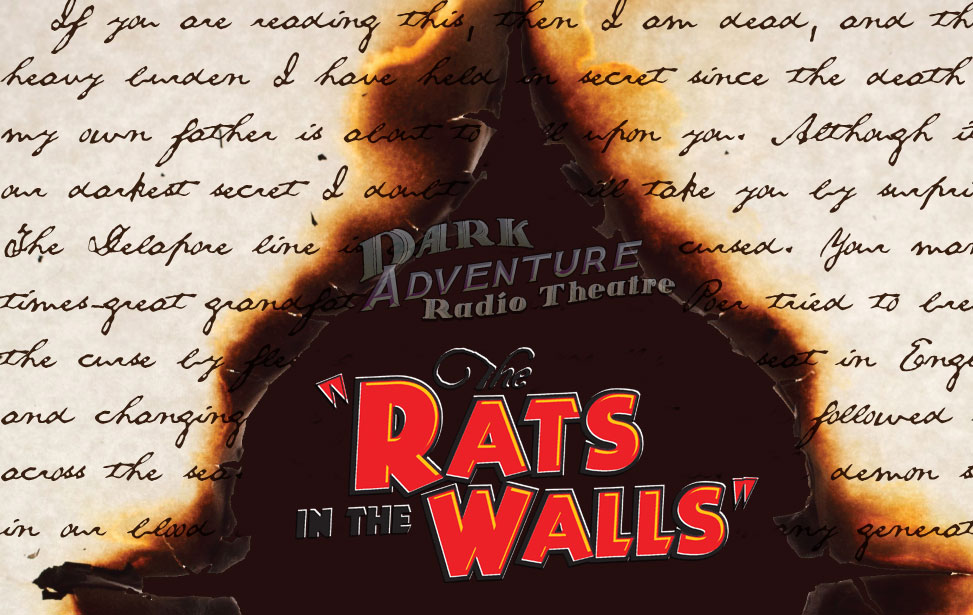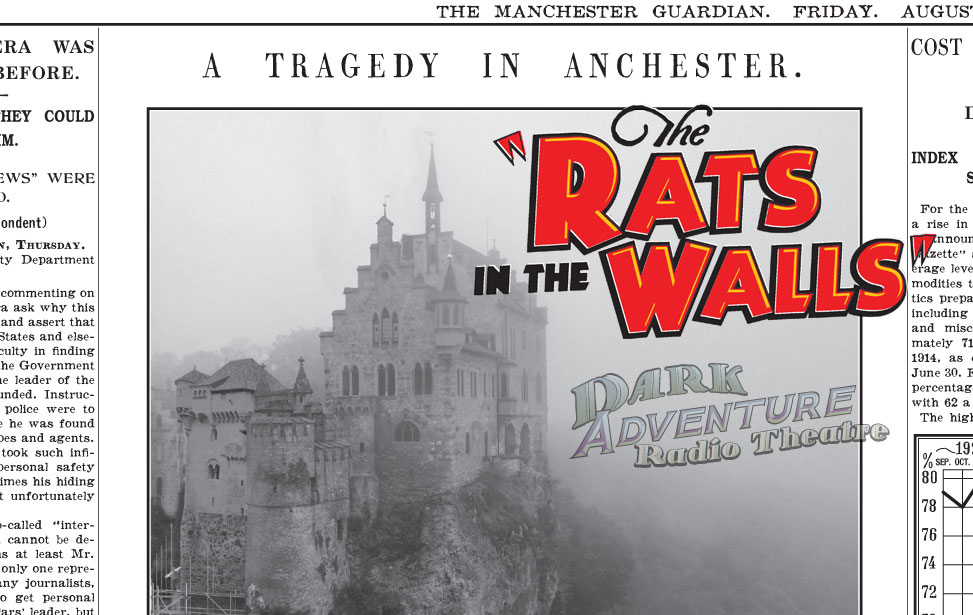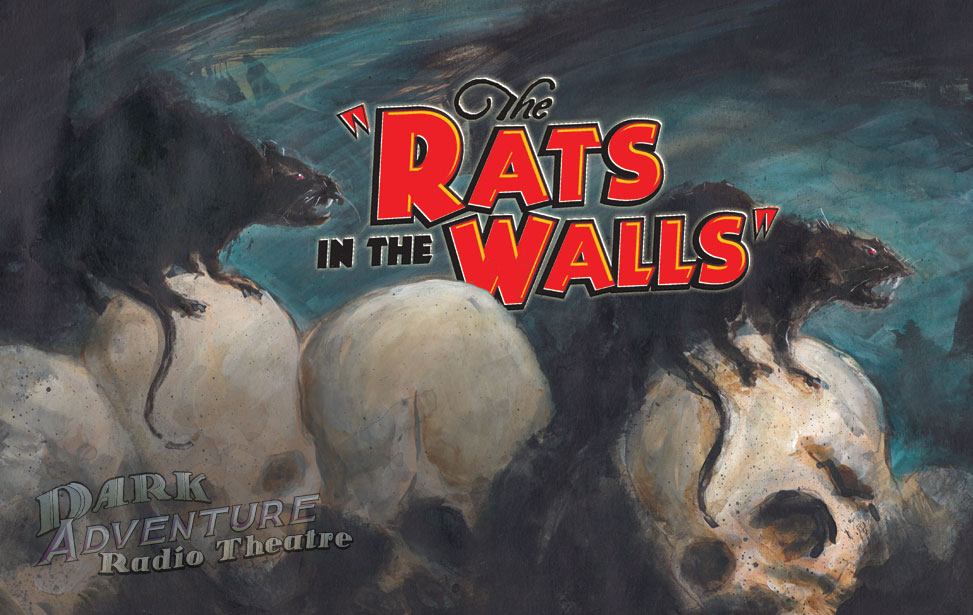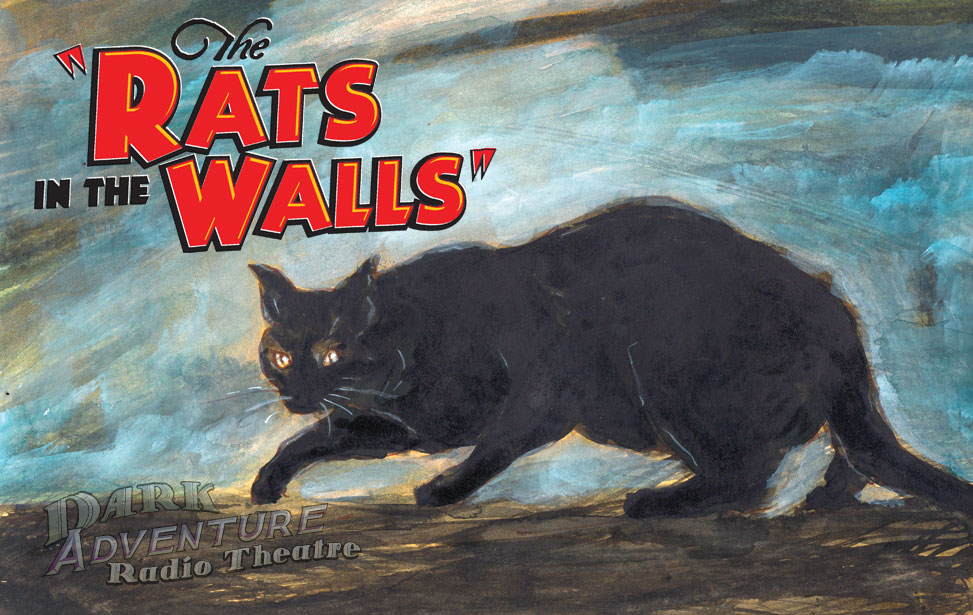The Rats in the Walls
"On every side of the chamber the walls were alive with nauseous sound — the slithering of ravenous, gigantic rats."
An American businessman undertakes the restoration of his ancient ancestral home in England. After moving in, he's haunted by strange phenomena, apparently coming from the very walls of the legend-haunted mansion. A team of experts joins him to dig into the centuried structure's shadowed past, and its shadowy cellars. Can the investigators solve the lingering mystery of the grim and rumor-shrouded priory, or are they merely ushering in the most horrific chapter of the house's monstrous history?
This episode is an adaptation of one of HPL's classic tales, written in 1923.
Get it now!Props
To enhance your listening pleasure, the HPLHS has packed the jewel case for The Rats in the Walls with carefully created props from the story. You'll get:
Track Listing
1. Opening 3:35
2. The Delapores 6:53
3. The Priory 7:56
4. The Dinner 10:04
5. The Rats 18:02
6. The Investigation 9:19
7. The Grotto 15:59
8. Closing 1:26
Total Runtime 73:13
Cast and Crew
Leslie Baldwin...Mrs. Mary Mulvany
Sean Branney...Matthew Delapore
Kacey Camp...Mildred, Lizzie Delapore
Dan Conroy...Captain Hill, Wakefield
David Carey Foster...Dr. Gilbert Trask
Hollie Hunt...Hannah
Andrew Leman...Sir William Brinton
Luci Lyle...Alfred Delapore, Miller, Young Matthew
Barry Lynch...Grandpa Delapore, Wilfred Crane
Grinnell Morris...Mr. Neville Thornton
Kevin Stidham...Captain Edward Norrys
Josh Thoemke...Announcer
Time Winters...Creighton Cobb, Professor Edward Thurlow Leeds
Based on the story by H.P. Lovecraft
Written by Sean Branney & Andrew Leman
Original music by Troy Sterling Nies
"The Bile Bean March" performed by Reber Clark
Vocals recorded at The Jungle Room, Glendale, CA
Audio engineering by Ben Soldate
Cover and disc illustrations by Darrell Tutchton
Prop Inserts by Andrew Leman & Sean Branney
Research Assistance by David G. Cercone II
Special Thanks to Clare Feikert-Ahalt at the Library of Congress and Lara Westwood of the Maryland Historical Society for their assistance in researching Jacobean land grants. Special Thanks to His Grace the Duke of Norfolk and Craig Irving of the Arundel Castle Archives for offering additional help. Special Thanks to George C. Spina for his gracious assistance in making connections. Thanks to Paul Brinkman of the North Carolina Museum of Natural Science and Bill Simpson of the Field Museum of Natural History for their advice about the scientific terminology to use when rats eat you.
Produced by Sean Branney and Andrew Leman
Script, Liner Notes & More
 One of the prop documents included with the CD version of this episode is a burned fragment of the Delapore family secret that Grandpa Delapore tried to give to young Matthew during the burning of Carfax. We prepared four different burned fragments, but each jewel case contains only one, distributed at random. If you could only see all four, you might have a better idea of what the secret is. To see the other three scraps, try comparing notes with other Dark Adventure Radio Theatre listeners in the Dark Adventure group on Facebook.
One of the prop documents included with the CD version of this episode is a burned fragment of the Delapore family secret that Grandpa Delapore tried to give to young Matthew during the burning of Carfax. We prepared four different burned fragments, but each jewel case contains only one, distributed at random. If you could only see all four, you might have a better idea of what the secret is. To see the other three scraps, try comparing notes with other Dark Adventure Radio Theatre listeners in the Dark Adventure group on Facebook.
 At one point in the show Mrs. Mulvany quotes a line from Catullus, poem #73, and the complete version is Desine de quoquam quicquam bene velle mereri, aut aliquem fiere posse putare pium. For those listeners who are not fluent in Latin, we thought we would provide a translation: "Give up wanting to deserve thanks from anyone, or thinking that anybody can be grateful."
At one point in the show Mrs. Mulvany quotes a line from Catullus, poem #73, and the complete version is Desine de quoquam quicquam bene velle mereri, aut aliquem fiere posse putare pium. For those listeners who are not fluent in Latin, we thought we would provide a translation: "Give up wanting to deserve thanks from anyone, or thinking that anybody can be grateful."
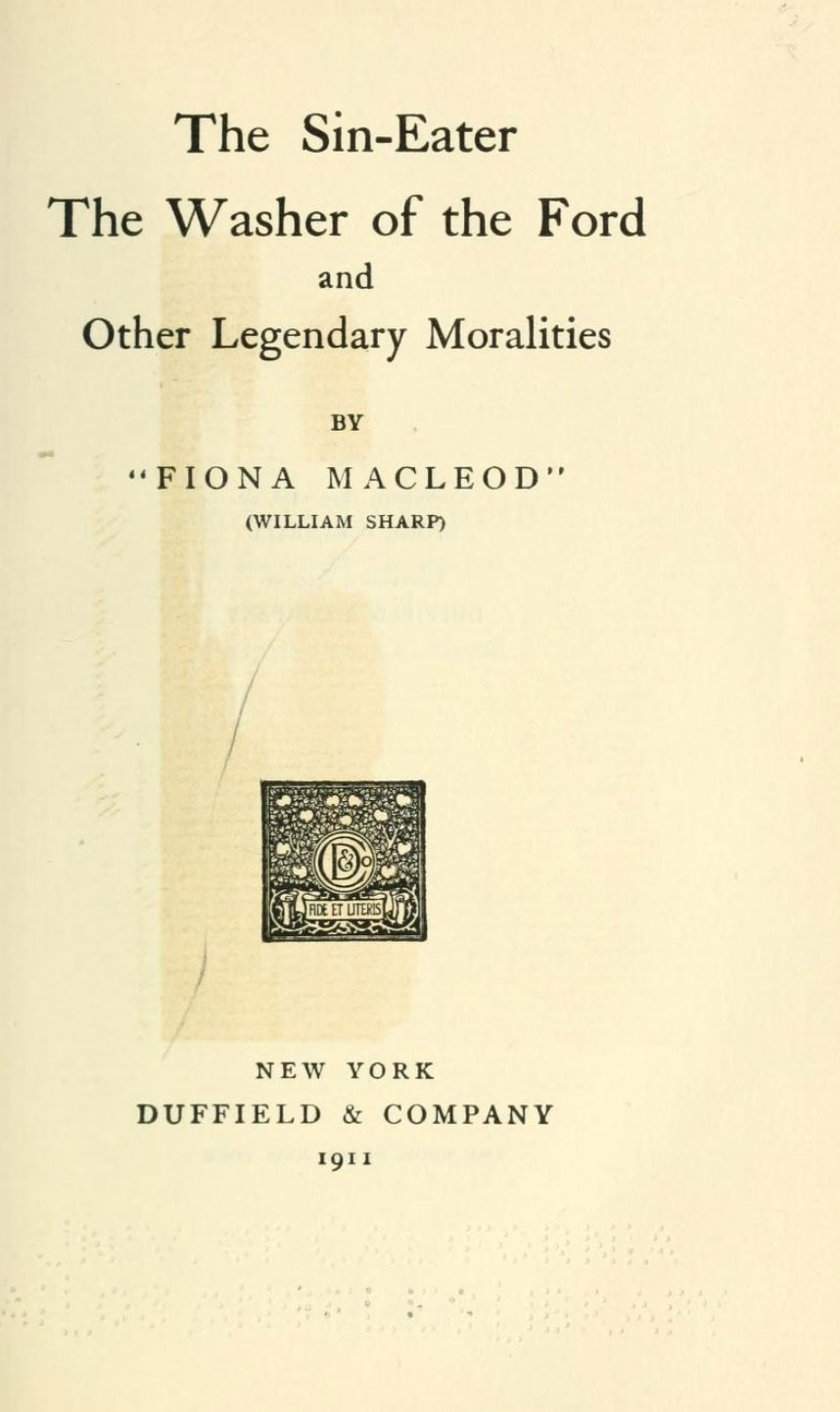 In the climactic scene of the story Delapore begins ranting in a combination of Gaelic, Latin, and Middle English. Lovecraft lifted the Gaelic from a story called "The Sin Eater" by Fiona Macleod, which was a pen-name of the Scottish writer and poet William Sharp (1855–1905). For those listeners who are not fluent in Gaelic, we thought we would provide a translation of the curse: "God against thee and in thy face—and may a death of woe be yours. Evil and sorrow to thee and thine!"
In the climactic scene of the story Delapore begins ranting in a combination of Gaelic, Latin, and Middle English. Lovecraft lifted the Gaelic from a story called "The Sin Eater" by Fiona Macleod, which was a pen-name of the Scottish writer and poet William Sharp (1855–1905). For those listeners who are not fluent in Gaelic, we thought we would provide a translation of the curse: "God against thee and in thy face—and may a death of woe be yours. Evil and sorrow to thee and thine!"
You can read "The Sin Eater" at the Internet Archive.
The Piltdown Man specimen was "discovered" by Charles Dawson, an amateur British archeologist who seems to have been something of a con man. When Lovecraft wrote the story in 1923, many people were familiar with Piltdown Man and most lay people believed it was genuine: Clarence Darrow even cited it as evidence during the Scopes Monkey Trial in 1925. In 1953 new evidence, including the fluorine absorption test, proved that the specimen was a forgery composed of a human skull of medieval age, the 500-year-old lower jaw of an orangutan, and chimpanzee fossil teeth, all of which had been stained and/or filed down to look old. The identity of the forger has never been definitively established, although the suspects include Dawson, Pierre Teilhard de Chardin, Martin A. C. Hinton, and Arthur Conan Doyle.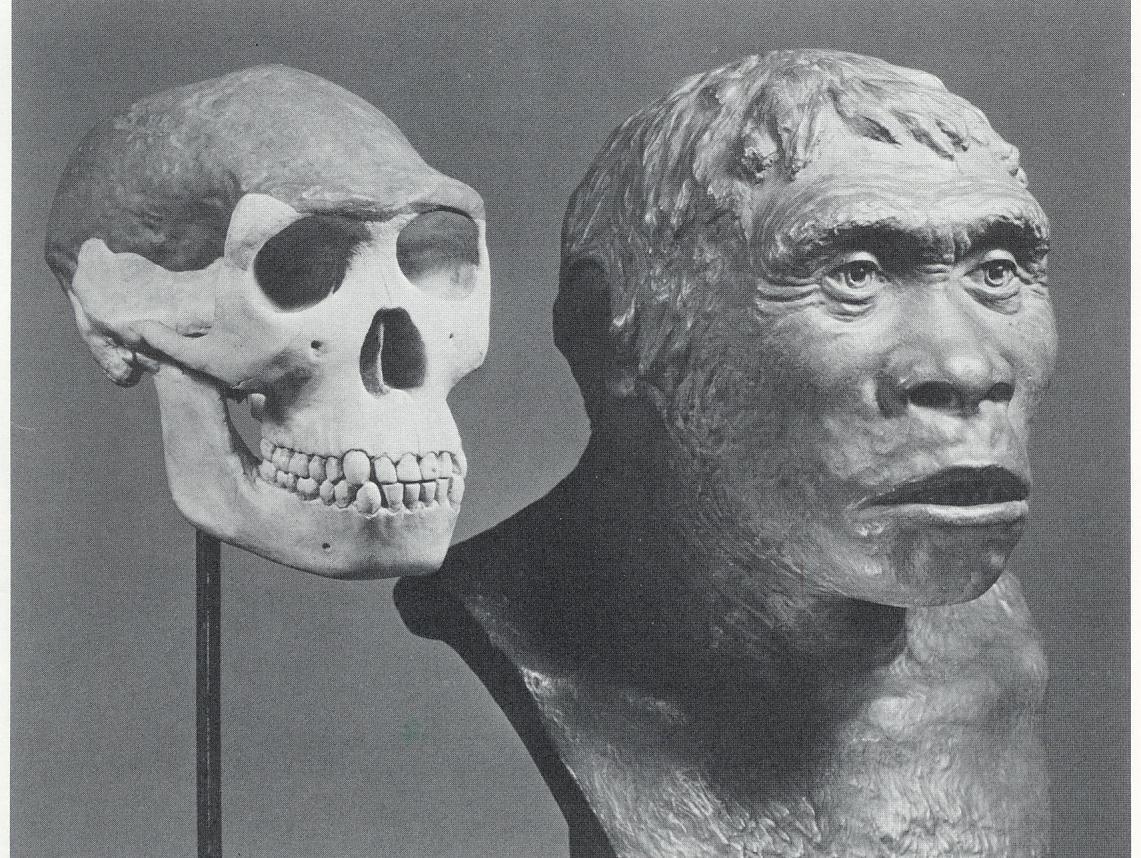
 Lovecraft repeatedly refers to "coarse vegetables" during the story, a phrase which struck us as slightly strange. But it seems that "coarse" vegetables are legumes, such as beans and lentils, plus root vegetables, cabbage, cauliflower and onion. Coarse vegetables are often grown on open land, rather than in greenhouses, and can be stored for longer periods than more delicate "salad" vegetables such as tomatoes, lettuce and cucumber.
Lovecraft repeatedly refers to "coarse vegetables" during the story, a phrase which struck us as slightly strange. But it seems that "coarse" vegetables are legumes, such as beans and lentils, plus root vegetables, cabbage, cauliflower and onion. Coarse vegetables are often grown on open land, rather than in greenhouses, and can be stored for longer periods than more delicate "salad" vegetables such as tomatoes, lettuce and cucumber.
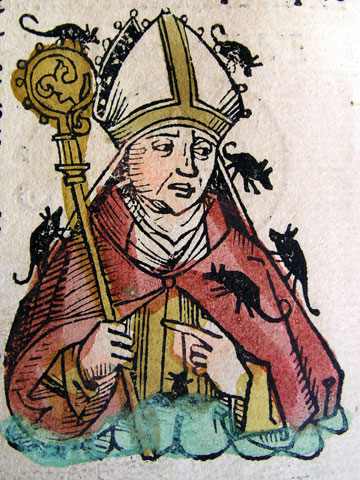 Some people believe that one of the inspirations for this story was the legend of Hatto II, archbishop of Mainz from 968 to 970. According to folktales, Hatto was cruel and oppressive, but justice was served when he was eaten alive by mice (or rats) in a tower on a small island in the Rhine near Bingen, Germany. There's a great old castle just across the river from the "Mouse Tower" called Ehrenfels Castle which might have inspired Exham Priory. Hatto was depicted, complete with rampaging rodents, in the Nuremburg Chronicle, and his story is told in Curious Myths of the Middle Ages by Sabine Baring-Gould.
Some people believe that one of the inspirations for this story was the legend of Hatto II, archbishop of Mainz from 968 to 970. According to folktales, Hatto was cruel and oppressive, but justice was served when he was eaten alive by mice (or rats) in a tower on a small island in the Rhine near Bingen, Germany. There's a great old castle just across the river from the "Mouse Tower" called Ehrenfels Castle which might have inspired Exham Priory. Hatto was depicted, complete with rampaging rodents, in the Nuremburg Chronicle, and his story is told in Curious Myths of the Middle Ages by Sabine Baring-Gould.
As we were working on the script for this episode, we became aware of the real de la Poer family, headed by Henry Nicholas de la Poer Beresford (pictured below), the 9th Marquis of Waterford in Ireland. He recently inherited the title along with the alleged curse that comes with it, and a house not entirely unlike Exham Priory called Curraghmore House: "The house itself looks forbiddingly gothic. It’s actually a Norman keep encased in a Victorian mansion, surrounded by Georgian ranges, a landscaped garden and 3,000 acres of land. The de la Poer family has lived here for 800 years." We wish them the best of luck with the curse. There's no mention of rat hordes, but the real de la Poers do seem quite fond of playing polo.
For your enjoyment, we present free PDF downloads of the final recording script and liner notes of "The Rats in the Walls". Note: this script is only for use for reading along with Dark Adventure Radio Theatre; no performance of the script may be made without written consent of the HPLHS.


